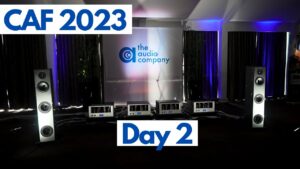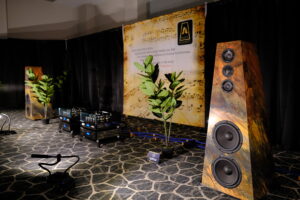
It’s finally time to drop the phrase “the resurgence of analog.” The boom in LPs and the products to play them has long since passed the “resurgence” phase and is now a full-fledged, integral component of the high-end landscape. Further evidence that LP playback has become just another widely accepted path toward musical pleasure—and an important business segment—was on display at this CES, where I saw and heard a flood of exciting new analog products.
We’ll start with Rega’s new RP6, a turntable/arm combination that replaces the venerable P5. The $1495 RP6 brings much of the technology of Rega’s upper-end ‘tables to a lower price. For example, the RP6 features the high-gloss black plinth of the P3-24 along with the machined-aluminum feet from the upper-end P9. The external power supply is all-new, and the unique platter is cast from glass with an outer glass ring for added inertia. Dual braces, one on either side of the plinth, stiffen the arm mount. The arm features Rega’s latest technology, including a lightweight one-piece casting. The RP6 is available with Rega’s Exact cartridge for $1995. This looked like a lot of turntable for the money.
Pro-Ject introduced no fewer than four new models, ranging in price from $399 to $12,000. The Pro-Ject Debut Carbon replaces the Debut III and features a carbon-fiber, rather than aluminum, armtube. This makes the Debut Carbon the lowest-priced record player with a carbon-fiber tonearm. The ’table also features a full 12** platter (up from 11** in the Debut III) upgraded motor-isolation system, RCA jacks so that you can use your own phono cables, and a choice of seven colors. The outstanding Ortofon 2M Red cartridge (itself $99) is included in the $399 price. Great analog has never been more affordable.
Next up the line is the Xperience Basic +, an entirely new model added to the line between the Xperience Classic 2 and the RM-5.1SE. This $1200 system is available in black acrylic or clear acrylic, and comes with a Sumiko Blue Point 2 cartridge.
At the $3000 price point, Pro-Ject offers the Xtension 10 and its 10” EVO tonearm. The Speed Box motor controller is built into the plinth. The Xtension 10 comes with a hinged dustcover, dedicated record clamp, an upgraded phono cable. This gorgeous ’table is available in applewood, mahogany, olivewood, or piano black.
Finally, in a significant move up-market, Pro-Ject showed the $12,000 HL Signature. The ’table features dual motors, each driven out of phase with respect to the other, flanking a magnetic flywheel bearing that in turn drives the platter. The mass-loaded plinth is supported by magnetic-repulsion feet for greater isolation. An elaborate digital display on the plinth shows text as well as the speed readout and other data. The integral arm is a new 12” design. Twelve grand is entirely new territory for the value-oriented company.
Bergmann, the Danish firm that had a huge hit with the Sindre, a $21,000 table featuring a linear-tracking air-bearing tonearm and air-bearing platter, introduced two new models, one above and one below the Sindre. The $12,000 Magne looks very much like the Sindre and is in fact the least expensive turntable to offer a linear-tracking air-bearing tonearm and air-bearing platter. The Magne is designed to bring simple “plug ‘n play” setup and operational convenience to a linear-tracking air-bearing record player. It lacks the Sindre’s elaborate constrained-layer-damped plinth, but retains much of the technology that make the Sindre so successful.
At the other end of the scale, Bergmann introduced the Sleipner, an all-out implementation of the Danish company’s technologies. The air supply is now digitally controlled, and the platter features vacuum hold-down. The plinth is made from a six-layer sandwich consisting of three boards of powdered granite/epoxy binding material, two layers of aluminum, and one layer of bitumen, all covered in a 12mm-thick coat of hand-painted and polished polyvinyl. The price varies from $48,100 to $50,200 depending on finish.
Analog Made in Germany (AMG, or Analog Manufaktur German in German) might be a new name on the turntable scene, but its founder and designer is certainly not new to turntables. Werner Roeschlau, the driving force behind AMG, has been a behind-the-scenes manufacturer of a famous turntable brand but decided to launch his own line incorporating ideas he’d worked on for more than a decade. An aviation engineer by training and an audiophile by avocation, Werner built an engineering business in 1985 just north of Munich that later began producing turntables for another company. AMG’s first product is the Viella 12 (or simply the V12). Just about every component in the V12 is novel, but you have to look closely to see how the V12 is different. The platter bearing, a cutaway of which was on display, is a serious piece of engineering on its own. The tonearm features a patented system that uses springs rather than bearings, a design that results in no play. Anti-skating compensation is realized with magnets inside the arm housing. All the components are made in-house in AMG’s shop. The $15,000 V12 is supplied with an arm, and is available with a wood skirt for $16,500.
In cartridge news, Ortofon followed up on the great success of the A90 with a new statement cartridge, the MC Anna. The $9000 moving-coil’s body is built using the Ortofon-developed technique called Selective Laser Melting in which tiny particles are fused together, layer-by-layer, to construct a solid cartridge body. This method, first used in the A90, has been applied to titanium in the Anna. Ortofon claims that the resulting titanium body achieves unprecedented rigidity and damping. In addition, the Anna features a new higher-efficiency magnet system that allows for a smaller armature and fewer turns on the coil for the same output level, greatly reducing the moving mass. The magnet system also reportedly allows each coil to “see” identical flux density regardless of the coil’s position. The Anna also introduces a new damping system that employs a tiny platinum disc sandwiched between layers of rubber. Overall, the Anna is nothing short of an all-out assault on the state of the art, and from a company with the history and engineering expertise to push the envelope.
Air Tight has replaced the PC-1 cartridge with the PC-1 S ($8500), an upgraded model that brings some of the performance attributes of the PC-1 Supreme (my reference) to a lower price.
You might have read on avguide.com Jonathan Valin’s enthusiastic blog about the $34,000 Ascona turntable from Germany’s Acoustic Signature. I learned at CES that the company makes an entire range of impressive ‘tables that start at $3500. The company has been building turntables for the past 15 years, and has its own machine shop with 20 CNC machines. The Barzetti is the company’s entry-level table that’s design to be simple to set-up and operate. The identically priced Manfred Mk. II is slightly tweaker, with an outboard motor controller, free-standing motor, and a solid-wood plinth. Both of these models look like conventional rectangular turntables. Moving up the line, we get into the all-aluminum models that forego the traditional look. With a price of $4500, the 51-pound Challenger Mk.II looks to be a substantial upgrade, with a large outboard motor, 40mm-thick chassis, 22-pound high-mass platter, and ability to accept up to three tonearms. Next in the line is the $7500 Storm. The 62-pound Storm offers an even heavier platter along with Acoustic Signature’s “Silencer” technology. This is the technique of drilling holes in the platter and inserting solid brass tubes that couple to the platter via dual O-rings. The pressure-fit brass inserts damp the platter, a feature demonstrated to me by “pinging” a platter with and without the “Silencer” feature and listening to the difference in platter ringing. The $13,500 Thunder takes this idea to the next level, employing 28 Silencers around the platter. The Thunder also features three motors and DSP motor control. Which brings us to the $34,000 Ascona, the company’s statement product. This 180-pound ‘table is massively built, with a 14** platter, 24 Silencers around the inner part of the platter, an additional 30 Silencers around the platter perimeter, and Silencers built into the motor housing.
In non-analog news, DEQX demonstrated its long-awaited HDP-4 loudspeaker/room-correction system. The $4995 HDP-4 can operate on high-resolution signals (up to 192kHz/24-bit), features more digital inputs than the HDP-3, has the provision for an optional USB input (price TBD), and active balanced analog inputs. The digital section is all new, with more powerful digital processing. DEQX offers an upgrade program to HDP-3 owners. Watch for Robert E. Greene’s full review in an upcoming issue.
Jonathan Valin later in this report describes having a rare “epiphany” in certain rooms, in which the system so totally disappears that the music seems to just exist independently of the hardware. I heard this in the Perfect8 Technologies/BAlabo room along with Jonathan, but also experienced it in the Zesto Audio room at T.H.E. Show at The Flamingo. The Zesto system included the company’s Andros PS1 phonostage, Avid Volvere turntable, Origin Live tonearm, Dynavector XV-1S cartridge, Lindemann electronics, and TAD Compact Reference loudspeakers, all connected by WyWires cabling with Acoustic Field room treatments. The system, put together by Zesto, Lindemann, and retailer Audio Revelation, was absolutely jaw-dropping in its presence and realism.
__________
Robert Harley’s Best of Show
Best Sound (cost no object)
The new Hansen E series (Emperor and Prince), TAD/Zesto/Lindemann, Wisdom LS4, Magico Q7 with MIT cable, Venture Ultimate Reference, Perfect8 The Point Mk. 2 driven by the incomparable BAlabo electronics, and Talon Phoenix driven by VAC all produced great sound, but if forced to choose just one system that was “the best of show” it would be the stunning MBL 101 X-treme.
Best Sound (for the lowest price)
Revel’s new $1700 per pair stand-mounted M106 sounded like it should cost $5k. And the M106 is just one product in an eight-speaker line. Expect greatness at affordable prices when these loudspeakers are released in April.
Most Significant Product Introduction
The Wadax La Pasión active loudspeaker ($106k) pushes the envelope in loudspeaker design with its integral DSP, separate woofer and midrange amplifiers, and a dedicated DAC that can drive the tweeter directly with no amplifier or passive crossover in the signal path.
Greatest Technological Breakthrough
Although planar-magnetic drivers were developed decades ago, Wisdom’s modern implementation of this technology certainly qualifies as a breakthrough both in the extraordinary driver construction and in the sound quality it produced.
Most Important Trend
The mainstreaming of analog. No longer a niche or “resurging” format, vinyl playback has become just another integral component of the high-end scene.

By Robert Harley
My older brother Stephen introduced me to music when I was about 12 years old. Stephen was a prodigious musical talent (he went on to get a degree in Composition) who generously shared his records and passion for music with his little brother.
More articles from this editorRead Next From Show
See all
Best of Show: Southwest Audio Fest 2024
- Mar 18, 2024

Capital Audio Fest 2023 | Day 2 Show Report
- Nov 17, 2023




















